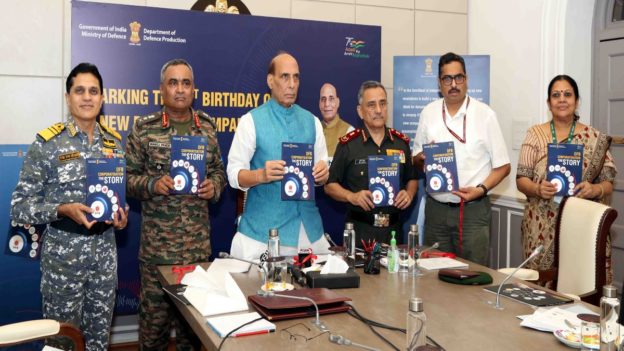The year 2022 has seen some of the biggest acquisitions in the defence sector in India. Several policy initiatives brought in reforms to encourage indigenous design, development, and manufacture of defence equipment.
The year 2022 has seen some of the biggest acquisitions in the defence sector in India. While the Armed Forces were equipped with state-of-the-art equipment, major reforms were rolled out to reduce the import of military equipment.
Several policy initiatives brought in reforms to encourage indigenous design, development, and manufacture of defence equipment. The major thrust of the reforms has been on promoting self-reliance in defence manufacturing and technology in the country.
Defence Acquisition Procedure (DAP) 2020
The Ministry of Defence (MoD) initiated major reforms which addressed the challenges of reducing defence imports. This included giving priority to the procurement of capital items from domestic sources under the Defence Acquisition Procedure (DAP)-2020.
One of the major initiatives is the announcement of 18 major defence platforms for industry-led design & development in March 2022. It included lightweight tanks, hypersonic glide vehicles, unmanned autonomous AI-based land robots, 127 mm naval guns, electric propulsion (engines) for ships and standoff airborne jammers. The platforms including naval ship-borne unmanned aerial systems and lightweight tanks were also identified for their design and development by the private sector.
According to the defence ministry, out of the 18 platforms, 14 will be developed by the private sector under the ‘Make-I’ category of the DAP 2020.
The policy aims to underline ‘Make-I’ under the DAP 2020 as the key driver to achieve self-reliance by involving greater participation of the Indian industry in the development of defence equipment.
To bring the private industry into the realm of military equipment, the government brought out the concept of the Special Purpose Vehicle (SPV) model. Defence policy outlines two platforms to be developed under the SPV model. The platforms identified for development under the SPV model are Indian Multi-Role Helicopter (IMRH) and Long-Range Unmanned Aerial Vehicles (UAVs).
Private industry can now work on the crucial element of design and development which so far has largely been the sole responsibility of the Defence Research and Development Organisation (DRDO).
Positive indigenisation lists
In a new approach, the government announced a series of Positive Indigenisation Lists for defence weapons and equipment which would not be imported.
The defence ministry launched such policy direction under the notification of four positive indigenisation lists. It identifies a total of 411 items of services and three positive indigenisation lists of 3,738 items of Defence Public Sector Undertakings (DPSUs), for which there would be an embargo on imports beyond the timelines indicated against them.
While the first positive indigenisation list of 101 military items was notified in August 2020, the second list of 108 items in May 2021, and the third list actually brought major platforms and equipment under the overall scheme of indigenization.
Again, the fourth list of another 101 items was announced by the Prime Minister during the opening ceremony of DefExpo 2022 in Gujarat in October. The List focused on government-owned DPSUs to minimise imports.
Simplification of industrial licensing process
The government announced the simplification of the industrial licensing process with a longer validity period. This enabled private players to fulfil complex contractual obligations with ease. The simplification removed the barriers that required the industry to submit the whole contractual obligation from scratch once the terms end. According to the data from the government, a total of 595 industrial licences have been issued to 366 companies operating in the defence sector till October 2022. The simplification process led to cost reduction in repeat orders which was also seen as a major impediment under the DAP 2020.
Besides, the government also launched an indigenisation portal namely SRIJAN to facilitate indigenisation by Indian Industry including schemes involving start-ups & Micro, Small and Medium Enterprises (MSMEs).
Innovations for Defence Excellence (iDEX)-Prime
In continuation of the iDEX, the MoD extended the programme to Defence Excellence (iDEX) Prime. The iDEX-Prime will support projects, requiring support beyond Rs 1.5 crore up to Rs 10 crore to help ever-growing start-ups in the defence sector. The Grant-in-Aid is up to Rs 10 crore which is for the development of high-end solutions. It included problem statements under which startups will offer solutions in terms of the design and development of the sub-systems for the armed forces.
The scope iDEX-Prime further broadens into key areas, especially in the domain of Artificial Intelligence (AI). The policy prioritises AI in Defence. In a major announcement, during the first ever ‘AI in Defence’ symposium and exhibition organized by the Ministry of Defence in New Delhi, the defence minister launched 75 newly-developed Artificial Intelligence (AI) products.
The products fall under various domains such as AI Platform Automation; Unmanned and Robotics systems; Block Chain-based Automation; Command, Control, Communication, Computer and Intelligence, Surveillance and Reconnaissance; Cyber Security; Human Behavioural Analysis; Intelligent Monitoring Systems; Lethal Autonomous Weapon Systems; Logistics and Supply Chain Management. It also includes setting up AI-based stations for operational data analytics, manufacturing, and maintenance.
Another policy response came from the government towards the opening up of Defence Research & Development (R&D) for industry, start-ups and academia by earmarking 25 per cent of the defence R&D budget.
Defence export policy
Defence export saw massive growth which is backed by policies to support the export of military hardware to friendly foreign countries. In fact, India’s defence exports stood at a record Rs 14,000 crores in 2021-22. Defence export policy outlines that by 2023, defence exports will cross Rs 19,000 crores and achieve the target of Rs 25,000 crores worth of exports of defence equipment by 2025. India’s defence exports achieved a six-fold increase between 2017 and 2021, taking defence export from Rs 1,520 crore to Rs 8,435 crores.
https://www.financialexpress.com/defence/major-indian-defence-reforms-of-the-year-2022/2930923/?utm_source=defence_landing_page&utm_medium=article_listing_widget&utm_campaign=Tags





